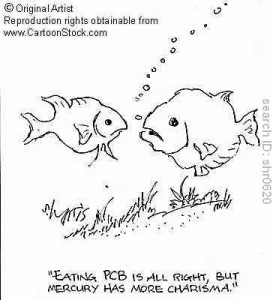For many decades in the United States, the ocean was seen as the ultimate wastebasket, where all of our wastes could be diluted and forgotten. Not for long, however, could these wastes be forgotten: Today, in the words of the magnificent Susan Thistle, we recognize pollution as one of the top two environmental problems in the world (the other being ). Thus, in this week’s fateful trip to the Whale Museum, as tempted as I was by preserved porpoise fetuses and whale parasites, it was the colorful diagram at the end describing pollution by polychlorinated biphenyls, or PCBs, that caught my attention.
The PCB story, it seems, follows a similar pattern of technological innovation providing a quick and convenient solution, followed by years of use of such technology… and then, decades later, discovery of the harm such innovation has perpetrated on the environment for years. This story starts in the “Roaring Twenties,” as industrial production was exploding. With a little extra money to spend, Americans started pimping their closets and cribs with ready-to-wear clothes and appliances like electric refrigerators (History Channel).
It was in this industrial climate, in 1929, that PCB’s first came on the scene. Produced from carbon, hydrogen and chlorine atoms, PCB’s were twentieth-century industrialist’s wing man. Non-flammable, chemically stable and electrically insulating, with a high boiling point, PCBs could be used in hundreds of industrial applications, as plasticizers in paints, as thermal insulation in fiberglass, felt, foam and cork, as lubricant in transformers, capacitors and other electrical equipment, and in many other uses (EPA). Thus, the era of PCBs began.
Starting in the 1930s, however, workers at plants which used PCBs started reporting symptoms of illness. Scientists began to suggest links between PCBs and liver disease and cancers. Finally, in 1979, the EPA banned the manufacture of PCBs in the United States (Katers). Now, PCBs have been demonstrated to cause cancer in animals and have been linked to rare liver cancers and malignant melanoma, as well as other non-carcinogenic effects (EPA).
The problem with PCBs are also what has made them so useful. Because of their stability, PCBs typically don’t evaporate or readily dissolve in water, and are very persistent in the environment. PCBs are a lesson in proper disposal: A lot of the contamination we feel today is because of not taking care of our waste in the past. Industrial wastes somehow found their way (a.k.a., were dumped) into surroudiing rivers, and some communities incinerated municipal waste (containing PCBs), producing nasty by-products like hydrogen chloride. Landfills, the cemeteries for outdated electrical junk, often contain transformers, capacitors and other appliances which can release PCBs into the air. According to GreenFacts, about 10% of the PCBs produced in 1929 remain in the environment today.
In the case of Free Willy and all his friends, PCBs are very soluble in fat and other substances (GreenFacts), passed on and building up in the food web over time (through the processes of bioaccumulation and biomagnifications, recently described in a truly magical presentation by Stuart Munsch.)
For years, PCBs have been one of the main threats to the whales of the Puget Sound.
“Human Health Hazards – PCBs and Your Health.” Environmental Health Resources. 12 July 2010. Wisconsin Department of Health Services. 23 Nov 2010 < http://www.dhs.wisconsin.gov/eh/hlthhaz/fs/PCBlink.HTM#Fact%20Sheets>.
Katers, Rebecca Leighton. “The History of PCBs—When were health problems detected?” Fox River Watch. Clean Water Action Council. 23 Nov 2010 <http://www.foxriverwatch.com/monsanto2a_pcb_pcbs.html#2>.
“Polychlorinated Biphenyls (PCBs).” US EPA. 12 Oct 2010. United States Environmental Protection Agency. 23 Nov 2010 < http://www.epa.gov/epawaste/hazard/tsd/pcbs/pubs/effects.htm>.
“The Roaring Twenties .” History Channel. A & E Television Network. 22 Nov 2010 <http://www.history.com/topics/roaring-twenties#a1>.
“Scientific Facts on PCBs Polychlorinated biphenyls.” GreenFacts.. 2006. Cogeneris sprl . 23 Nov 2010. <http://www.greenfacts.org/en/pcbs/index.htm#2>.




